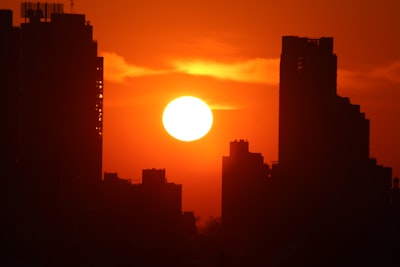How Record-Breaking Heatwaves Are Remaking America: Climate Anxiety, Urban Adaptation, and the Future of Our Cities
Introduction: When 100 Degrees Becomes the New Normal
As another wave of punishing heat descends on the Eastern United States, headlines about triple-digit temperatures in cities once known for their mild summers are becoming all too familiar. It sparks a larger question that goes beyond daily weather forecasts: How prepared are our urban environments—and the people who live in them—for the era of supercharged heatwaves? And perhaps more fundamentally, what does it do to our collective psyche when “unprecedented heat” becomes routine?
This deep dive explores the complex interplay of climate anxiety, urban adaptation, and how the relentless rise of extreme temperatures is not just melting records, but reshaping the very fabric of American city life.
The Science: Why East Coast Cities Are Now Sweltering
The Heat Is Here—and It's Different
East Coast cities from Boston to Atlanta are set to break temperature records, with meteorologists predicting more than a dozen urban centers hitting or surpassing 100°F this summer. According to NOAA, average summer temperatures in parts of the eastern U.S. have increased by over 2°F since 1970, but it's the frequency and intensity of extreme heat events that's most alarming.
Key Factors Driving the Heat
- Urban Heat Island Effect: Dense building materials and limited green space trap and radiate heat, making city centers several degrees hotter than outlying areas.
- Global Warming: Elevated greenhouse gases are amplifying baseline temperatures, increasing both averages and extremes.
- Humidity’s Role: Eastern cities face not just dry heat but sweltering humidity, pushing heat indices (what it “feels like”) well above thermometer readings.
Historical Context: How Heatwaves Changed America
Remember Chicago, 1995?
One of the deadliest heatwaves in U.S. history struck Chicago in July 1995, killing over 700 people in just five days. Elderly and low-income residents suffered disproportionately due to power outages, poor infrastructure, and lack of air conditioning.
Now: It's Not the Exception, But the Rule
Fast-forward to the 2020s. Cities once accustomed to heat as an occasional concern now face the specter of chronic extreme events. NOAA’s data shows that in the 1960s, New York City averaged two days a year above 90°F; today, that number has more than tripled.
Urban Adaptation: The Race to Cool Our Concrete Jungles
Can Our Cities Keep Up With the Heat?
Cooling Innovations and What Cities Are Doing
- Green Roofs and Urban Forests: New York and Philadelphia have launched programs to plant millions of trees and install heat-reflective rooftops.
- Cooling Centers: Cities like Washington, D.C. and Boston are expanding public spaces outfitted with AC and water to protect vulnerable residents.
- Smart Infrastructure: IoT sensors and predictive analytics are being deployed in cities like Atlanta to map and mitigate urban hotspots.
The Challenge: Equity and Access
Not all neighborhoods benefit equally. Wealthier districts can afford air conditioning and resilient infrastructure, while marginalized communities are often left battling dangerous temperatures with limited resources.
The Mental Toll: Climate Anxiety in the Age of Triple-Digit Cities
Climate Anxiety Is Real—and Rising
A recent study in the journal Nature Climate Change found that over two-thirds of Americans report anxiety or distress about extreme weather. Among young people, “eco-anxiety” has become a defining stressor, with climate-driven disasters outpacing even economic or political worries.
Why Heatwaves Hit Harder Than Other Disasters
- Invisible Threat: Unlike hurricanes or floods, heatwaves are silent and slow, making it hard to “see” the danger until it’s personal.
- Daily Life Disruption: Triple-digit temperatures strain power grids, close schools, and keep people indoors—eroding community life and social cohesion.
- Loss of Trust: Repeated warnings of “unprecedented” heat, followed by insufficient public action, deepen frustration, cynicism, and helplessness.
Expert Quote
“Heatwaves redefine our understanding of safety and livability in the places we call home. It’s not just about discomfort—it's about identity, belonging, and psychological security.”
— Dr. Chloe Meinert, Environmental Psychologist, Columbia University
The Prediction: Are American Cities Facing a Tipping Point?
Will Extreme Heat Change Where—and How—We Live?
Bold prediction: Within a generation, insurance, real estate, and public health in major U.S. cities will be fundamentally reshaped by heat resilience—or the lack of it.
- Property Values: As persistent heat and blackouts spread, buyers may “flee the furnace,” pushing up prices in cooler regions.
- Migration: Studies by the Yale Program on Climate Change Communication suggest that 30% of U.S. adults have considered relocating due to climate factors; heat tops the list for many.
- Urban Redesign: Expect to see a renaissance in city planning, with green corridors, water features, and cool-material pavements becoming political priorities.
What Can Be Done—and What You Can Do
Personal Resilience in a Hotter World
- Stay Informed: Use weather and air quality apps to plan activities and protect health.
- Advocate: Support policies demanding heat adaptation—like tree-planting, cooling centers, and upgraded power grids—in your community.
- Prepare: Retrofit homes for energy efficiency and join local efforts to check in on vulnerable neighbors.
The Big Picture: From Anxiety to Agency
Rather than succumb to climate anxiety, channel concern into action. The more citizens demand heat-resilient infrastructure and social safety nets, the more livable our cities can become—even as the mercury soars.
Conclusion: The Future Belongs to the Adaptable
For millions in America’s eastern cities, the era of 100-degree summers is already here. Whether this reality breeds despair or sparks innovation depends on our collective willingness to acknowledge the risk and act decisively—before 100 degrees is no longer news, but just another day.
This article was inspired by the headline: 'As heat peaks for most of East, these cities are set to hit 100 degrees - The Washington Post'.

Comments
No comments yet. Be the first to comment!